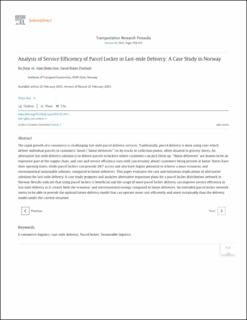| dc.contributor.author | Dong, Bo | |
| dc.contributor.author | Hovi, Inger Beate | |
| dc.contributor.author | Pinchasik, Daniel Ruben | |
| dc.coverage.spatial | Oslo, Norway | en_US |
| dc.date.accessioned | 2023-06-13T08:40:23Z | |
| dc.date.available | 2023-06-13T08:40:23Z | |
| dc.date.created | 2023-02-27T15:24:37Z | |
| dc.date.issued | 2023-02-22 | |
| dc.identifier.citation | Transportation Research Procedia. 2023, 69 918-925. | en_US |
| dc.identifier.uri | https://hdl.handle.net/11250/3071070 | |
| dc.description | This is an open access article under the CC BY-NC-ND license (https://creativecommons.org/licenses/by-nc-nd/4.0)
Peer-review under responsibility of the scientific committee of the Transport Infrastructure and Systems (TIS ROMA 2022)
10.1016/j.trpro.2023.02.253 | en_US |
| dc.description.abstract | The rapid growth of e-commerce is challenging last-mile parcel delivery services. Traditionally, parcel delivery is done using vans which deliver individual parcels to customers’ home (“home deliveries”) or by trucks to collection points, often situated in grocery stores. An alternative last-mile delivery solution is to deliver parcels to lockers where customers can pick them up. “Home deliveries” are known to be an expensive part of the supply chain, and cost and service efficiency vary with (uncertainty about) customers being present at home. Stores have their opening times, while parcel lockers can provide 24/7 access and also have higher potential to achieve a more economic and environmental sustainable solution, compared to home deliveries. This paper evaluates the cost and emissions implications of alternative solutions for last-mile delivery. A case study proposes and analyzes alternative expansion plans for a parcel locker distribution network in Norway. Results indicate that using parcel lockers is beneficial and the usage of more parcel locker delivery can improve service efficiency in last-mile delivery as it creates both the economic and environmental savings compared to home deliveries. An extended parcel locker network seems to be able to provide the optimal future delivery model that can operate more cost-efficiently and more sustainably than the delivery model under the current situation. | en_US |
| dc.description.abstract | Analysis of Service Efficiency of Parcel Locker in Last-mile Delivery: A Case Study in Norway | en_US |
| dc.language.iso | eng | en_US |
| dc.publisher | Elsevier | en_US |
| dc.title | Analysis of Service Efficiency of Parcel Locker in Last-mile Delivery: A Case Study in Norway | en_US |
| dc.title.alternative | Analysis of Service Efficiency of Parcel Locker in Last-mile Delivery: A Case Study in Norway | en_US |
| dc.type | Journal article | en_US |
| dc.type | Peer reviewed | en_US |
| dc.rights.holder | © 2023 The Authors | en_US |
| dc.description.version | publishedVersion | en_US |
| cristin.ispublished | true | |
| cristin.fulltext | original | |
| cristin.qualitycode | 1 | |
| dc.identifier.doi | 10.1016/j.trpro.2023.02.253 | |
| dc.identifier.cristin | 2129724 | |
| dc.source.journal | Transportation Research Procedia | en_US |
| dc.source.volume | 69 | en_US |
| dc.source.pagenumber | 918-925 | en_US |
| dc.relation.project | Norges forskningsråd: 321146 | en_US |
